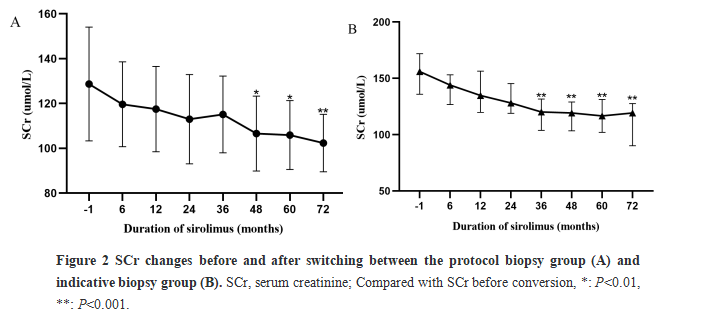Long-Term Effects of Conversion from Calcineurin Inhibitors to Sirolimus for the Recipients with Low Immunological Risk in Renal Allograft
National Clinical Research Center of Kidney Diseases, Jinling Hospital, Nanjing University Jinling School of Medicine, Nanjing, China
Meeting: 2022 American Transplant Congress
Abstract number: 1706
Keywords: Efficacy, Kidney transplantation, Prognosis, Sirolimus (SLR)
Topic: Clinical Science » Kidney » 38 - Kidney Immunosuppression: Novel Regimens and Drug Minimization
Session Information
Session Name: Kidney Immunosuppression: Novel Regimens and Drug Minimization
Session Type: Poster Abstract
Date: Tuesday, June 7, 2022
Session Time: 7:00pm-8:00pm
 Presentation Time: 7:00pm-8:00pm
Presentation Time: 7:00pm-8:00pm
Location: Hynes Halls C & D
*Purpose: To observe the long-term effects and prognosis of conversion from calcineurin inhibitors (CNIs) to sirolimus in biopsy-proven low immunological risk renal transplant recipients (RTRs).
*Methods: The long-term efficacy of conversion from CNIs to sirolimus in low immunological risk RTRs with no signs of acute or chronic graft rejection proved by biopsy was retrospectively analyzed. We collected the clinical and histological data, observing allograft survival and adverse events after conversion during follow up.
*Results: This study enrolled 38 patients, including 12 cases received protocol biopsy and 26 cases were performed with indication biopsy due to increased serum creatinine (SCr). Mean duration of sirolimus therapy was 80.71±41.37 months (range:12-194 months). SCr steadily declined after conversion. In indication biopsy group, the median SCr(156.47 μmol/L pro-conversion)decreased significantly 2 years later (P<0.001) and reduced to 123.76 μmol/L at last follow-up. In protocol biopsy group, the median SCr was 127.30 μmol/L pro-conversion, SCr remained stable for a long time and decreased to a median of 111.38 μmol/L 4 years later (P<0.001). Only 2 cases lost the graft which may result from the higher SCr before conversion. New onset hypertriglyceridemia (n=8), new onset hypercholesterolemia (n=13), de novo PRA (n=7), new rejection (n=2), pulmonary infection (n=5), new onset proteinuria (n=18) were observed in the long-term follow-up period. Repeated biopsies showed no significant signs of rejection in 5 cases. Analysis showed RTRs with positive proteinuria before conversion had shorter duration of taking sirolimus (P=0.004). High SCr levels (>176.8 μmol/L) linked to poor prognosis (P=0.046).
*Conclusions: Conversion from CNIs to Sirolimus based on biopsy is safe and effective for renal allografts in low immune-risk recipients, most of them can benefit from improved GFR and long-term allograft survival after conversion. Even the low immunological risk RTRs received protocol biopsy can also benefit from this conversion.
To cite this abstract in AMA style:
Wu Q, Chen J, Cheng D, Ni X, Li X, Xie K, Jiqiu W. Long-Term Effects of Conversion from Calcineurin Inhibitors to Sirolimus for the Recipients with Low Immunological Risk in Renal Allograft [abstract]. Am J Transplant. 2022; 22 (suppl 3). https://atcmeetingabstracts.com/abstract/long-term-effects-of-conversion-from-calcineurin-inhibitors-to-sirolimus-for-the-recipients-with-low-immunological-risk-in-renal-allograft/. Accessed November 25, 2025.« Back to 2022 American Transplant Congress


